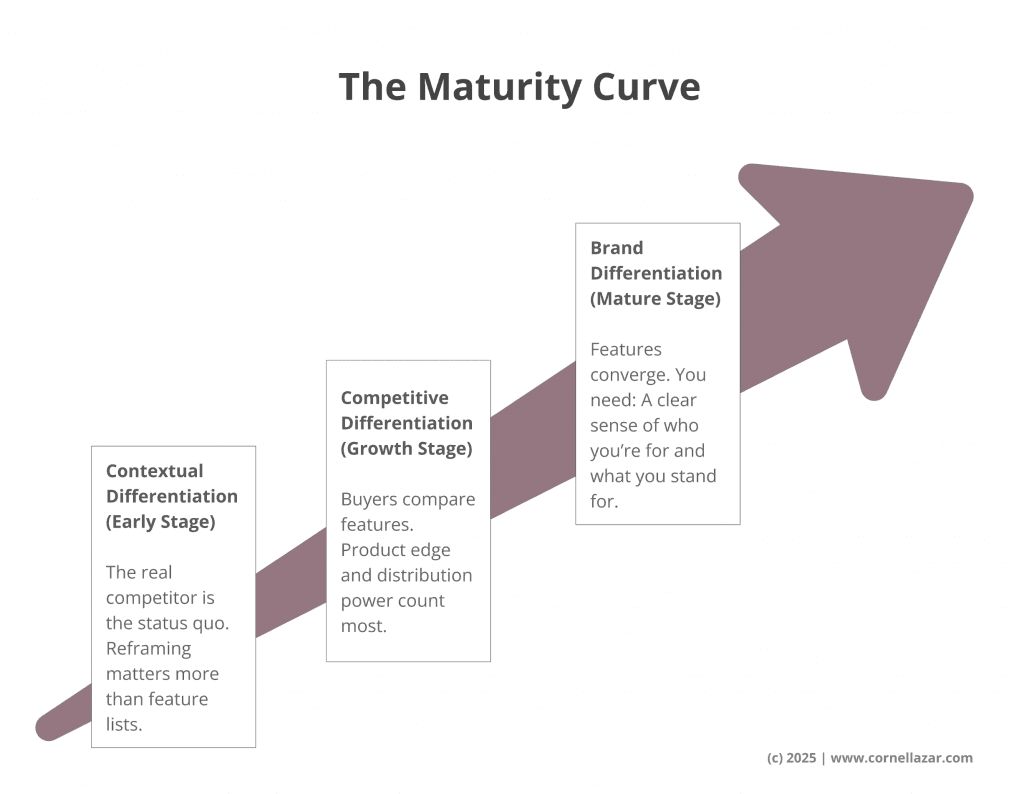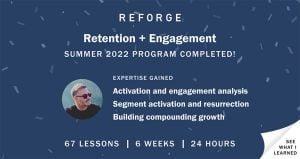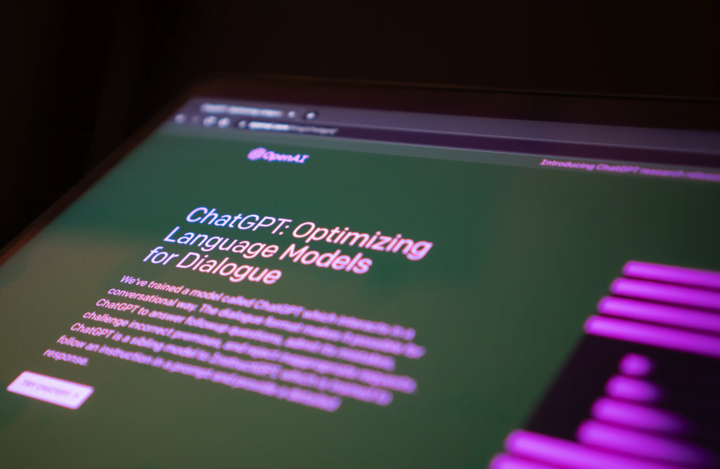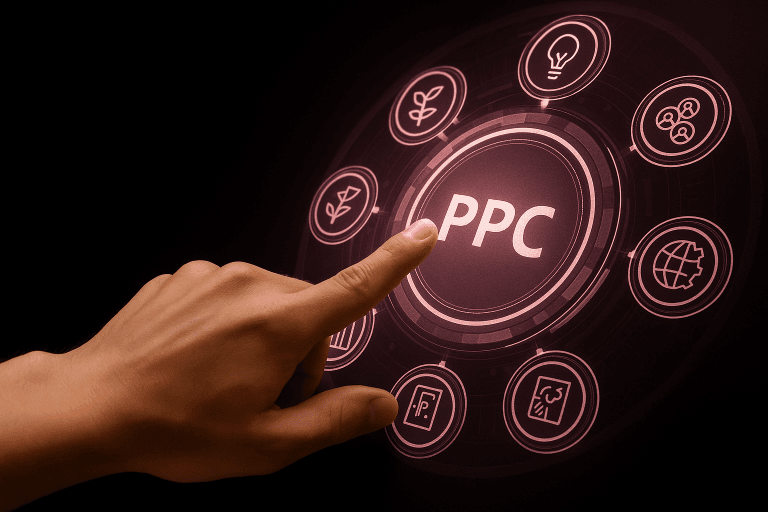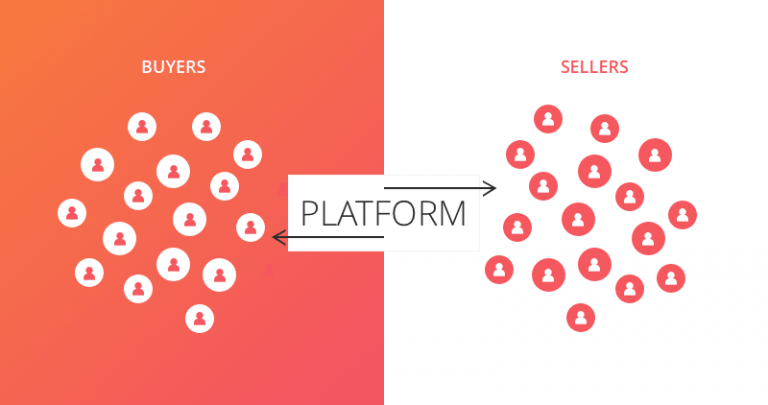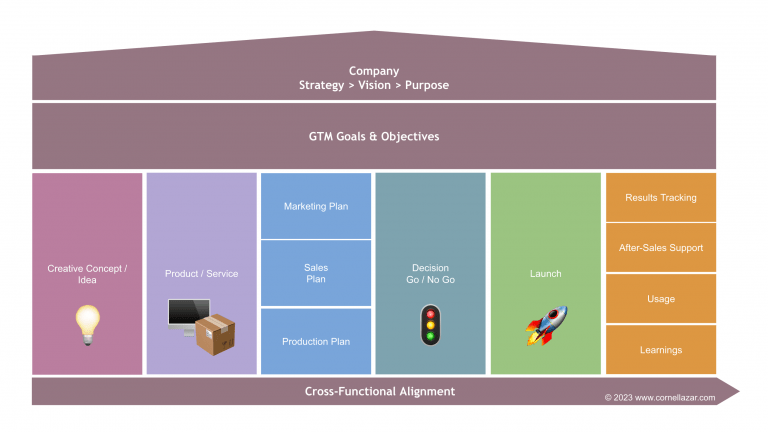If your market feels crowded and same-y, the answer isn’t louder design or flashier claims – it’s sharper differentiation.
In this article, I’ll show you how to help your brand stand out and spark growth by choosing a clear modifier within your category – then embedding it across your product, pricing, and behaviours.
Key Takeaways
- Understand how differentiation evolves as markets mature
- Use the Category + Modifier formula for sharp positioning
- Select a modifier you can prove and sustain without a six-month study
- Build a brand narrative using Promise, Proof, Pay-off
- Activate differentiation where decisions happen
- Measure both behaviour and economics – not just brand recall
- Avoid cosmetic moves and copycat traps
- Follow a 90-day playbook to land differentiation without stalling
The Maturity Curve (and Why “Brand” Matters Most at the End)
Markets follow a predictable arc. Your approach to differentiation should evolve with it.
Contextual Differentiation (Early Stage)
In the early days, your real competitor is the status quo. You win by showing why the old way no longer works. The message is: “Instead of doing X the old way, do Y this new way.” Reframing matters more than feature lists. At this stage, education is your edge.
Competitive Differentiation (Growth Stage)
As adoption rises, so does competition. Buyers compare features. Product edge and distribution power count most. Here, it’s about why you over the rest.
Brand Differentiation (Mature Stage)
Eventually, features converge. Everyone says “secure”, “scalable”, “intuitive”. What breaks the tie? Brand. A clear sense of who you’re for and what you stand for.
Why This Matters
Knowing your category’s maturity helps you reach for the right lever. In saturated markets, brand becomes function, not fluff.
Brand Differentiation in One Line: Category + Modifier
A simple formula for sharp positioning:
We are a [familiar product category] + [sharp modifier].
The category gives buyers a frame of reference. The modifier creates contrast.
Five Proven Modifier Types
Ethical stance: Privacy-first, carbon-neutral, cruelty-free. When backed by policy, ethics become trust assets.
Tight ‘Who’: Serve a focused group and build around their quirks.
Feature bundle: Three integrated features that solve a real job.
Process difference: Compete on delivery – “no code”, “onboarded in 48 hours”.
Pricing model: Flip the logic – flat fee, outcome-based, cost-plus.
Keep your one-liner crisp. If it needs commas, it’s too long.
Choosing Your Modifier (Without need of a 6-Month Research Project)
You don’t need months of research. You need clarity.
Separate Table Stakes from Spikes
List essentials like security and support – that’s table stakes. Then choose 2–3 areas where you’ll stand out. Make trade-offs explicit.
Apply Three Tests
Relevance: “I need a [category] that [modifier]” must feel natural.
Credibility: Can you prove it fast?
Durability: Will it hold for 18–24 months?
Pick an Enemy
Bloat, busywork, dark patterns – naming what you’re against sharpens what you’re for.
Be yourself; everyone else is already taken.
Oscar Wilde
Choose the modifier that forces meaningful change. It’s usually the better bet.
Turn the Modifier into a Brand People Can Feel
A modifier is just a sentence. A brand is when that sentence shows up in your behaviour.
Build a Narrative: Promise, Proof, Pay-off
Promise: The value you offer in a nutshell.
Proof: Real reasons to believe.
Pay-off: The result buyers want, in their words.
Use Distinctive Brand Assets
A tagline that carries your modifier
Visuals that don’t mimic the leader
Voice that fits your stance
Rituals that prove it: “We reply in an hour”, “We ship on Wednesdays”
Design an Experience That Proves the Point
Defaults that reinforce the promise
Rituals aligned to your stance
Policies that show your commitment
Here’s an example: If your modifier is “fair, flat pricing,” prove it with one clear plan, a visible calculator, fast billing resolution, and transparent renewals.
Activation: Turn Meaning into Market Share
Category Entry Points
Target moments that trigger purchase: funding rounds, quarter ends, or compliance deadlines. Match your message to the moment.
Match Distribution to Your Modifier
Ethical stance: Use PR, partnerships, community
Tight ‘Who’: Niche podcasts, industry associations
Process difference: Product-led flows, side-by-side comparisons
Pricing model: ROI tools, clear procurement packs
Feature bundle: Interactive demos, use-case stories
Enable Your Sales Team
Equip them with:
One-pager: your market, modifier, enemy, three proofs
Talk tracks that explain trade-offs
Aligned incentives that reward behaviour (e.g. time-to-live for speed promises)
Measuring Whether It’s Working
Real brand differentiation moves both behaviour and numbers.
Leading Indicators
Growth in branded search
More shortlist wins in RFPs
Higher trial-to-conversion rate
Shift in win reasons from “features” to “fit” or “trust”
Shorter sales cycles
More partner referrals
Lagging Indicators
Higher realised prices
Better retention in your segment
Higher LTV/CAC
Lower support cost if delivery is smoother
Test Without Paralysis
Matched-market rollouts
Brand tracking (aided and unaided recall)
Page tracking (do proof pages correlate with wins?)
Traps to Avoid
- Cosmetic-only changes: No one buys a new logo
- Too many modifiers: One clear edge wins
- Copycat messaging: Sounding like the leader isn’t a strategy
- Weak distribution: Sharp ideas still need reach
- Over-relying on features: They decay – behaviours stick
- Rebrands that reset trust: Keep recognisable assets
A 90-Day Differentiation Playbook
You don’t necessarily need a rebrand. You need momentum.
Days 1–15: Diagnose
Interview 10 customers and 10 lost prospects
Map table stakes vs spikes
Draft 5 modifiers with proof points
Days 16–30: Decide
Choose one modifier, one support theme
Define the enemy
Test with 3 customers, 3 prospects, 3 sellers
Days 31–60: Design
Build Promise–Proof–Pay-off into assets
Choose 2 distinct brand codes
Align product defaults, policies, and service
Create enablement tools and proof content
Days 61–90: Deliver
Launch in one focus segment
Run two demand plays
Track five metrics weekly
Review and refine
Scorecard KPIs to track
Track these KPIs weekly to stay focused on performance:
📊 Quantitative Metrics
Share of branded search: Are more people actively seeking you out?
Demo conversion rate: Are qualified leads engaging seriously?
Median time-to-value: How quickly do new customers see results?
Win rate in target segment: Are you converting where you’re focusing?
Average discount given: Are you defending your price?
🔎 Qualitative Insight
Capture a least a minimum of one win / loss reason weekly: a short buyer quote or theme explaining why you won or lost a deal. It adds context to your metrics and keeps the view human.
Differentiation Is a Decision
Brand differentiation isn’t decoration – it’s direction. It’s a choice to stand for something sharp, real, and provable.
When features converge, winners behave differently. They show up with a modifier that means something … and then prove it at every touchpoint.
Ethics. Audience focus. Feature bundles. Process edges. Pricing logic. Whatever your path, make it real in product, service, and story.
Remember the quote by Oscar Wilde, “be yourself; everyone else is already taken.” In a world of identikit brands and lookalikes, that’s not just good advice: That’s your strategy!
